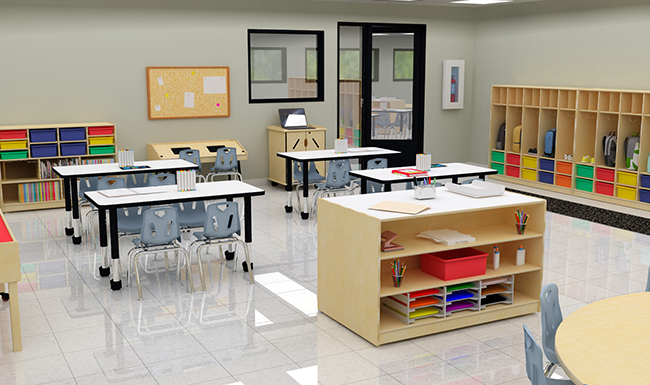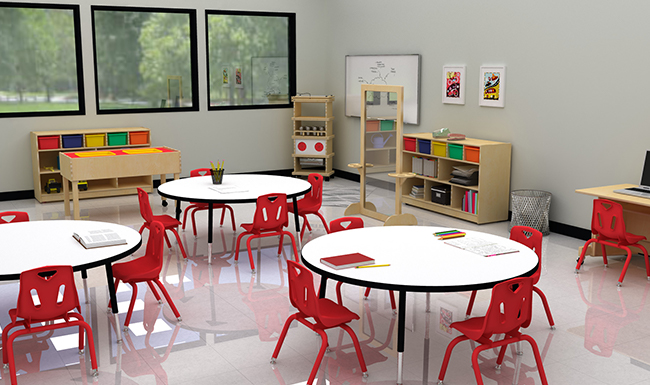
Reminiscing about the first days of kindergarten or elementary school brings that familiar song back, the one that includes the line, “…we’re all in our places with bright shining faces.” What a difference a few decades have made.
As classroom teachers and instructional leaders have planned for the opening of schools in the fall of 2021, new priorities are front and center. Among them, and often at top of the list, are figuring out how to design places for learning to ensure physical distancing without disrupting classroom culture and community and keeping children safe—all while creating an all-important sense of belonging and excitement about learning.
For many early learning environments and elementary classrooms, open plans have already replaced the desks in rows. Classrooms have become hives for learning. And now they’re spaces that need to support quiet, independent reading, group projects, 1:1 time with teachers, technology access, whole class learning, and areas for collaboration, dramatic play, art, and even physical activities.
All together, traditional classrooms have a growing number of constantly evolving needs to accommodate. As educators and administrators look for answers, these six tips can serve as inspiration for redesigning, rearranging, and reprovisioning learning spaces to meet learning, safety, and budgetary needs.
Classrooms, particularly those in older facilities, are often small. And even in settings where classrooms offer ample space, furniture with wheels and locking casters can make it easier and faster to rearrange and accommodate teaching and learning, as students’ and curriculum needs evolve. Jonti-Craft’s furniture featuring MAXBracket® casters make moving furniture around a space easy! These heavy-duty casters feature a caster and a three-point connection bracket rolled into one. This unique design adds triangular strength and allows furniture (especially heavy storage units) to be moved easily without causing stress on the wheel. And best of all, the wheels are made of hard rubber and won’t leave black marks on your floor! Between the powerful ball-bearings, hard rubber wheels, and a solid steel design, these MAXBrackets outperform plastic wheels when it comes to durability.
From creating ad hoc centers for small group and individual student activities, to making “circle time” for the whole class easy to manage, mobile furnishings from Jonti-Craft can help teachers streamline classroom setup and management. Another consideration? Mobile furniture can help maintain optimum distance between students throughout the school day, and that supports critical health and safety protocols.
Modular furniture can give educators even more choices for configuring classrooms, daycares, preschools, libraries, learning labs, and other environments. Jonti-Craft Collaborative Tables can easily convert from individual desks into circles, U-shaped configurations, or other small-group settings to adapt the space to the instructional need or activity at hand. It’s a great way to encourage collaboration when needed, and to make it easier for teachers to move easily around the room as students are working on their tasks and projects.
The modular KYDZ Suite® line from Jonti-Craft optimizes space and flexibility in any learning area. It can be rearranged, downsized, or added onto at any moment making it adaptable to changing needs.
Plus, with added pieces, like modular storage units, makerspace centers, and special-purpose pieces like sensory tables, easels, or dramatic play units, Jonti-Craft furniture makes it possible to keep classrooms organized and provide the right environment for learning across the curriculum.
Store a variety of items with products like the Jonti-Craft® Super-Sized Combo Mobile Storage Unit. Create an additional work surface by adding a Magnetic Write-n-Wipe back to a storage unit. Make one piece of furniture work twice as hard, with the Jonti-Craft Store More-Table or Jonti-Craft STEM Makerspace Table. Provide a desktop for hands-on crafts and building projects that converts to a writing area with Berries Dry Erase Tables. These are just some of the options that are available with Jonti-Craft’s educational furniture. They’re a great way to add functionality to corners or other classroom areas that may be underutilized. When educators are looking for ways to support multiple activities and interactions among teachers and students, Jonti-Craft’s multi-purpose furniture can answer these needs affordably.
Classrooms are busy places, with all kinds of activities happening simultaneously. And each curriculum area typically requires its own sets of materials, equipment, and resources. Creative storage solutions can make a difference. From mobile storage carts and shelving designed to hold a mix of bins, trays, papers, and folders such as the Jonti-Craft Steam Multimedia Cart—to compact lockers and coat storage that fit against wall spaces, new storage options continue to make organization, access to materials, and classroom management easier for both teachers and students alike.

Health and safety have always been top priorities for schools and early childhood centers and now, those concerns have grown even more critical. From basics like KYDZSafe® rounded corners and KYDZHinges® that protect tiny fingers, all the way to KYDZTuff® surfaces that can be cleaned and sanitized multiple times a day, classroom furniture plays a key role in keeping classrooms clean, safe, and healthy. New innovations—like Jonti-Craft’s See-Thru Table Dividers and their line of Clean Hands Helper portable sinks, which don’t require plumbing hookups—are answering the need for hygiene in the classroom and other early learning spaces. And as health requirements evolve and social distancing needs change, furniture and seating that can be reconfigured quickly will contribute to keeping classrooms open, accessible, and productive.

The days of students sitting in neat rows are rapidly fading. Circular configurations, special functional areas, team or group pods, and others are effective ways to plan classroom spaces. Nick Schwarz, Chief Operating Officer at Jonti-Craft, a Wabasso, MN-based educational furniture manufacturer, noted, “Classroom design services and expertise have never been more important than now. Not only does this caliber of professional service help schools and educational organizations optimize their learning spaces, but professional space planners and architects are instrumental in adding the critical elements of health and safety into room design. And that’s essential in keeping school operating successfully for students, families, staff, and their communities.”
Jonti-Craft’s free Room Design service is a great option for teachers and educators alike. Their experts create exactly the kind of learning environment needed to accommodate curriculum, activities, age range, and a host of other factors that impact room layout. They understand how to place furniture and create “flow” among areas to help children feel comfortable, confident, and creative as they learn and grow. This helpful service makes it easy for educators to plan, design, and purchase an entire early learning space without the hassle and time of doing it themselves.
As educators in all types of learning areas continue to adjust, update, or expand their facilities, it’s always a smart strategy to consult with specialists in classroom design and furnishings. Then, educators can compare plans and options, costs, and other safety and health considerations to arrive at the optimum approach to classroom designing and outfitting their spaces. Looking at other schools’ solutions, talking to colleagues, and gathering input from staff, students, and families can impact your design decisions as well.
So yes, as the school year continues, all signs point to a great year of bright shining faces…all in their places—at school— while learning and thriving.

Melissa Potter is the Marketing and Communications Director at Jonti-Craft, Inc., a Minnesota based company that has been providing learning spaces with educational furniture for over 40 years.